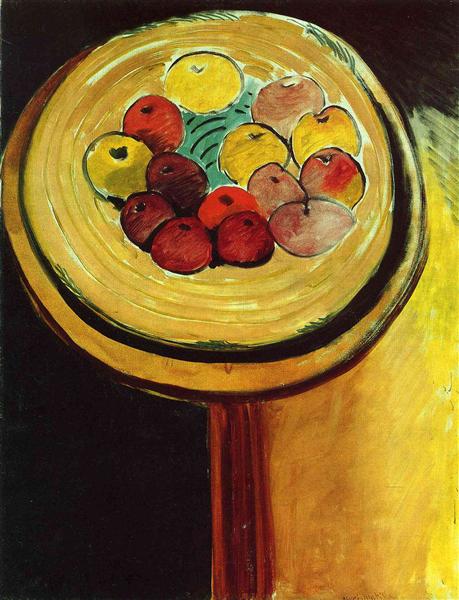Description
"Apples, 1916" by Henri Matisse is a painting that, although at first glance may seem simple in its representation of a still life of apples, reveals a profound complexity in terms of composition and color handling that only an master of art like Matisse could achieve. This work, framed within his prolific career, is a clear testimony of his ability to transform everyday subjects into vibrant and lively representations.
The composition of "Apples, 1916, 46x60" centers on a table holding a group of apples. The lightness with which Matisse approaches the arrangement of these elements suggests an apparent casualness, yet each element is meticulously placed to balance the composition. The apples, round and robust, are painted with a precision that gives them volume and weight, characteristics that contrast with the simplicity of the background. The lines defining the table are equally light and fluid, reminiscent of Matisse's characteristic use of drawing in his works, where lines and shapes flow naturally and gracefully.
The use of color in this painting is sublime. The apples, in different shades of red and green, capture the light in such a way that you can almost feel the texture of their skin. Matisse employs pure and contrasting colors that make the apples stand out against the neutral yet harmonious background, which introduces a pale blue. This background does not distract but rather enhances the fruits, providing a perfect setting that highlights their freshness and richness. The color palette, although limited, is used masterfully, demonstrating the artist's expertise in using color to create depth and dimension.
Although "Apples, 1916" does not include human characters as in some of his other works, the apples themselves become the protagonists of the scene. In their simplicity, these fruits speak to us of an intimate and meticulous observation of the natural world, a recurring theme in Matisse's work. The attention to detail and the representation of everyday life are characteristics that make this still life transcend its apparent simplicity.
It is important to place this work within the context of Matisse's career. By 1916, Matisse had already emerged as one of the leaders of the Fauvist movement, which focused on the expressive use of color. Although Fauvism as a movement was already in decline, its influence persisted in Matisse's work, and "Apples, 1916" is a clear example of this prolonged chromatic exploration. The freedom in the use of color that characterizes Fauvism is reflected in this work, where Matisse moves away from the faithful reproduction of nature to offer his own interpretation of it.
Matisse's paintings during this period also reflect a great influence from the travels he made throughout his life, bringing with him inspirations from the light and landscapes of the Mediterranean. The light and climate of these places deeply influenced the way he perceived and executed his color compositions.
In summary, "Apples, 1916" is a gem within the production of Henri Matisse. Through its seemingly simple composition and vibrant use of color, Matisse invites us to rediscover the beauty in the most everyday objects. It is a work that reminds us of Matisse's genius for transforming the common into something extraordinary, and his mastery in capturing the essence of what he observes with an unmistakable and deeply evocative style.

